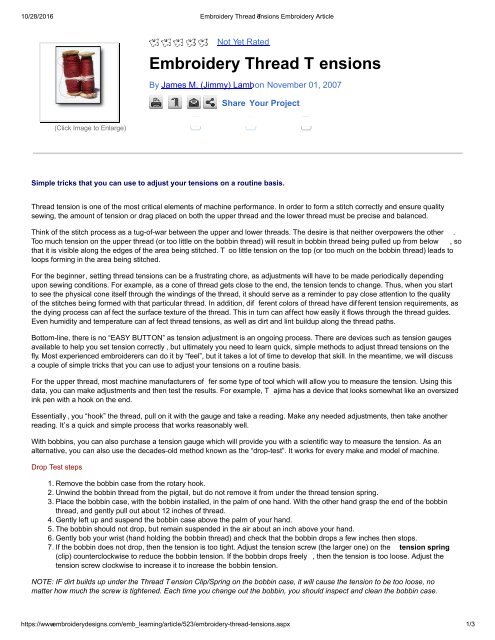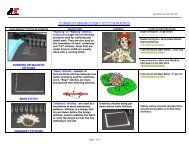Compiled Embroidery Skill Articles
You also want an ePaper? Increase the reach of your titles
YUMPU automatically turns print PDFs into web optimized ePapers that Google loves.
10/28/2016 <strong>Embroidery</strong> Thread Tensions <strong>Embroidery</strong> Article<br />
Not Yet Rated<br />
<strong>Embroidery</strong> Thread T ensions<br />
By James M. (Jimmy) Lamb on November 01, 2007<br />
Share Your Project<br />
(Click Image to Enlarge)<br />
0 0 0<br />
Simple tricks that you can use to adjust your tensions on a routine basis.<br />
Thread tension is one of the most critical elements of machine performance. In order to form a stitch correctly and ensure quality<br />
sewing, the amount of tension or drag placed on both the upper thread and the lower thread must be precise and balanced.<br />
Think of the stitch process as a tugofwar between the upper and lower threads. The desire is that neither overpowers the other .<br />
Too much tension on the upper thread (or too little on the bobbin thread) will result in bobbin thread being pulled up from below , so<br />
that it is visible along the edges of the area being stitched. T oo little tension on the top (or too much on the bobbin thread) leads to<br />
loops forming in the area being stitched.<br />
For the beginner, setting thread tensions can be a frustrating chore, as adjustments will have to be made periodically depending<br />
upon sewing conditions. For example, as a cone of thread gets close to the end, the tension tends to change. Thus, when you start<br />
to see the physical cone itself through the windings of the thread, it should serve as a reminder to pay close attention to the quality<br />
of the stitches being formed with that particular thread. In addition, dif ferent colors of thread have dif ferent tension requirements, as<br />
the dying process can af fect the surface texture of the thread. This in turn can affect how easily it flows through the thread guides.<br />
Even humidity and temperature can af fect thread tensions, as well as dirt and lint buildup along the thread paths.<br />
Bottomline, there is no “EASY BUTTON” as tension adjustment is an ongoing process. There are devices such as tension gauges<br />
available to help you set tension correctly , but ultimately you need to learn quick, simple methods to adjust thread tensions on the<br />
fly. Most experienced embroiderers can do it by “feel”, but it takes a lot of time to develop that skill. In the meantime, we will discuss<br />
a couple of simple tricks that you can use to adjust your tensions on a routine basis.<br />
For the upper thread, most machine manufacturers of fer some type of tool which will allow you to measure the tension. Using this<br />
data, you can make adjustments and then test the results. For example, T ajima has a device that looks somewhat like an oversized<br />
ink pen with a hook on the end.<br />
Essentially , you “hook” the thread, pull on it with the gauge and take a reading. Make any needed adjustments, then take another<br />
reading. It’s a quick and simple process that works reasonably well.<br />
With bobbins, you can also purchase a tension gauge which will provide you with a scientific way to measure the tension. As an<br />
alternative, you can also use the decadesold method known as the “droptest”. It works for every make and model of machine.<br />
Drop Test steps<br />
1. Remove the bobbin case from the rotary hook.<br />
2. Unwind the bobbin thread from the pigtail, but do not remove it from under the thread tension spring.<br />
3. Place the bobbin case, with the bobbin installed, in the palm of one hand. With the other hand grasp the end of the bobbin<br />
thread, and gently pull out about 12 inches of thread.<br />
4. Gently left up and suspend the bobbin case above the palm of your hand.<br />
5. The bobbin should not drop, but remain suspended in the air about an inch above your hand.<br />
6. Gently bob your wrist (hand holding the bobbin thread) and check that the bobbin drops a few inches then stops.<br />
7. If the bobbin does not drop, then the tension is too tight. Adjust the tension screw (the larger one) on the tension spring<br />
(clip) counterclockwise to reduce the bobbin tension. If the bobbin drops freely , then the tension is too loose. Adjust the<br />
tension screw clockwise to increase it to increase the bobbin tension.<br />
NOTE: IF dirt builds up under the Thread T ension Clip/Spring on the bobbin case, it will cause the tension to be too loose, no<br />
matter how much the screw is tightened. Each time you change out the bobbin, you should inspect and clean the bobbin case.<br />
https://www.embroiderydesigns.com/emb_learning/article/523/embroiderythreadtensions.aspx<br />
To be honest, more sewing tension problems are caused by the bobbin than the upper thread. However , since the upper thread is<br />
1/3




